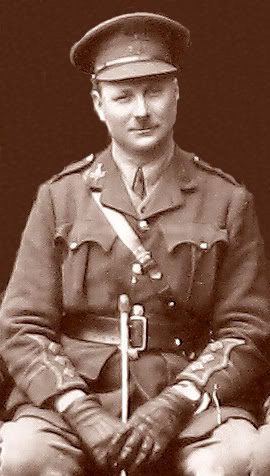
Submitted by Pat Burgess.
The Graham family were local to Barnard Castle, they lived on The Bank, where father John had a chemist and grocery business. John Austin was born on 2 March 1872.
After his time at school from 1886 until 1889, he took a Electrical Engineering apprenticeship. Later he started an electrical business with his brother – Graham Brothers Electrical Engineers in Middlesbrough.
He was secretary of the Saltburn R.N.L.I. and a gifted operatic singer.
Serving as a territorial captain, Austin Graham was with the 4th battalion when war broke out in August of 1914. He landed with the battalion at Boulogne on April 18th
1915 when the battalion was almost straight away thrown into the 2nd battle of Ypres. On April 24th Captain Graham and his men had their first taste of action in fierce fighting during the Battle of St Julien. On Whit Monday 1915 the battalion were in trenches astride the Menin Road at Hooge and Austin Graham was badly gassed and hospitalised with his injuries. In early 1918 the battalion were back in the Ypres sector and when the German Spring Offensive opened on March 21st they were in a position close to Hancourt. There followed nine days of fighting on the retreat under the enemy onslaught. A brief rest at Bethune followed this and then on April 8th the battalion was moved up to take part in the Battle of the Lys.
By now CO of the 4th battalion Major Austin Graham was wounded in action during efforts to hold a bridge at Sailly sur La Lys. He died of his wounds the following day April 11th 1918.
He is buried in Haverskerque British Cemetery.
Explore more memories from the ribbon
-
John O’Hern
John O’Hern is buried in Reeth Road cemetery, Richmond. He died of his wounds after the end of the First World War on 1 February 1919. He entered into service at the age of 29 years and 9 months while living at Mill Lane in Richmond. He worked at the paper mill and had also previously served in the 4th Territorial Battalion of the Yorkshire Regiment. His medal card shows his original regimental number (1669) and also his later number (200238) – as the 4th Battalion issued new nubmers in 1917. He was tried by Court Martial at Baizeiux on 9 October for being drunk on parade – after 6 days confinement he paid a 10 shilling fine. The card shows that not only did he receive the three well known medals nicknamed ‘Pip, Squeak and Wilfred’ – so called after a cartoon strip in the Daily Mirror, but also a Silver War badge due to his injuries towards the end of the war. Owing to a terrible gunshot wound to the spine, John O’Hern became paralysed. A bullet was removed from his spine through surgery in April 1918, but he died as a result of this battlefield injury months later.
-
George Ellis
Submitted by Pauline Blewis. George was born in Old Malton and joined the Green Howards in around 1905. In the same year he married Annie Hemstock, a Richmond girl. Their family of three sons and a daughter were raised in the barracks, now the Garden Village. George served during the Boer War and during the First World War was transferred to the 13th Battalion (October 1915)- the battalion was made up of ‘Bantams’. George served through the war up to the Battle of Cambrai. On 23rd November 1917 he was sent up to the front line with his battalion with the aim of taking Bourlon Wood and village. Tanks were sent in with the infantry following up, eventually the village was taken after hand to hand fighting. George died during this advance and while his body was never found his name is inscribed on Panel 5 of the Cambrai Memorial. After his death the family were moved from the barracks into a house inside Richmond Castle.
-
Albert Clifford
Submitted by Marcia Howard, a resident of Richmond. Albert William George Clifford was my maternal Grandfather born at Chipping Sodbury, Gloucestershire in 1886. Prior to his medical discharge in 1916, he was serving in Malta with No.1 Coy, of the Royal Garrison Artillery as a Gunner. He was subsequently presented with the Silver War Badge which in September 1916, King George V had authorised to honour all military personnel who had served at home or overseas since 4 August 1914, and who had been discharged because of wounds or illness. Following his return home to his wife and 2 small children in Gloucestershire, he became Chauffeur to the local doctor, where he also contributed to the recruitment drive popularly known as ‘Your Country Needs You’.
